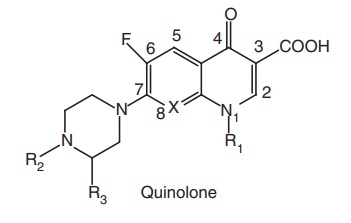Quinolone Antibacterials
| Home | | Medicinal Chemistry |Chapter: Medicinal Chemistry : Quinolone Antibacterials
Quinolones constitute a large class of synthetic antimicrobial agents that are highly effective in the treatment of many types of infectious diseases, particularly those caused by bacteria.
Quinolone Antibacterials
INTRODUCTION
Quinolones
constitute a large class of synthetic antimicrobial agents that are highly
effective in the treatment of many types of infectious diseases, particularly
those caused by bacteria. Quinolones are potent, broad-spectrum antibacterial
agents. The early congeners (nonfluorinated at C-6 position, such as nalidixic
acid) were limited to certain gram-negative infections, such as urinary tract
infections. However, the modern generation of fluoroquinolones, containing C-6
fluoro substituent and a cyclic basic amine moiety at C-7 position, surpass
their predecessors in terms of spectrum of activity and potency. This has
allowed for their use against a variety of gram-negative as well as some
gram-positive pathogens.

Many
analogues have piperazino groups on C-7 because of which they broaden the
spectrum, especially to gram-negative organisms, such as Pseudomonas aeruginosa, however, they also increase the affinity of
the compound for the gamma-aminobutyric acid (GABA) receptor, which contributes
to central nervous system (CNS) side effects. Quinolones are easily prepared
and administered via parenteral and oral routes, and are well tolerated.
Mode of action: Quinolones inhibit the action of bacterial DNA
gyrase enzyme. This enzyme is responsible for supercoiling and compacting
bacterial DNA molecules into the bacterial cell during replication. This action
is accomplished by modifying the topology of DNA via supercoiling and twisting
of these macromolecules to permit DNA replication or transcription.
Related Topics
